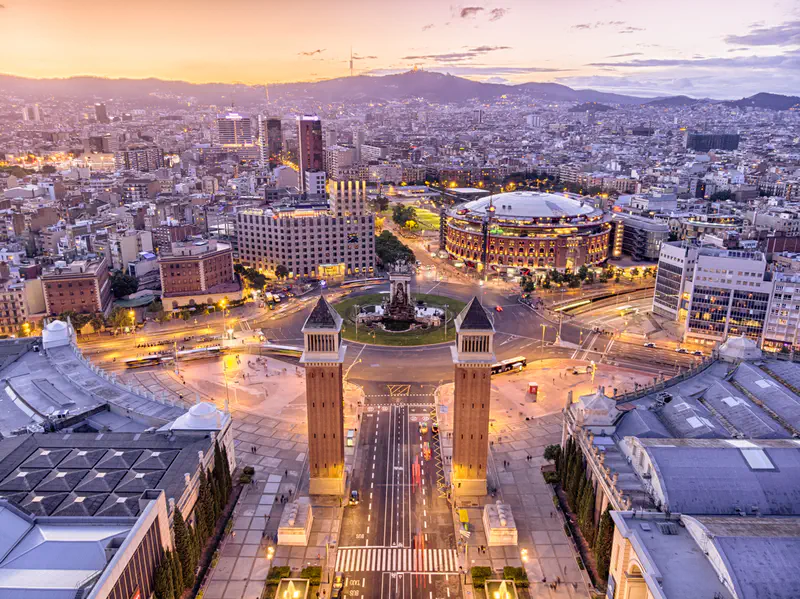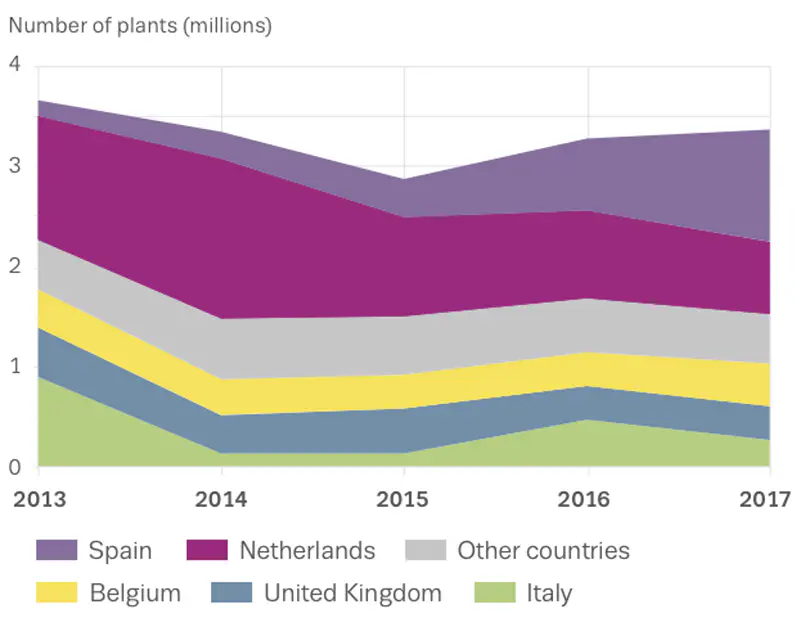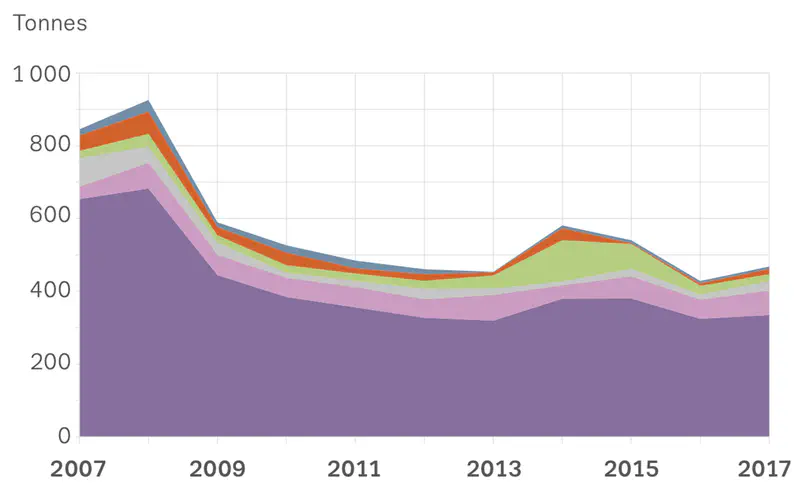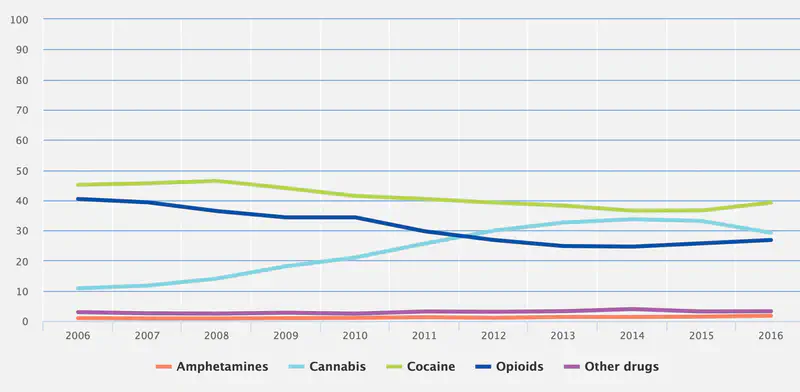Spain’s Dilemma with Drugs and Alcohol

Any country that is crisscrossed with drug trafficking routes struggles with the same problem: Lots of availability of trafficked drugs for their own population. And Spain is in this exact situation.
Spain has emerged as a major transit point for drugs being trafficked from South America to any point in Europe. That primarily means cocaine and heroin.
Historically, cocaine has been coming into Europe through large container ports such as Antwerp and Rotterdam.1 And now, Spain has been added to the list. In Spain, the primary ports are Algeciras, Valencia and Marin.
Spain and Belgium alone account for 60% of the cocaine seized in the EU. Cocaine is also shipped by jet from South America, with North Africa often serving as a transit point.
Cannabis
From Morocco comes herbal and resin cannabis. The fact that Morocco and Spain are only separated by nine miles of water means that these drugs can even be trafficked onto the European continent by jet ski.2 And they are, especially when truck and ferry routes from Africa to Europe may be restricted or subjected to thorough inspections.
Much of these shipments are destined for other European points but of course, some is diverted to Spain’s domestic market. As a result, Spain has one of the highest rates of cannabis use in the EU.3 Eighteen percent of those aged 15 to 34 have used cannabis in the past year, with 25% of men in this age range using the drug and 11.5% of women.
Catalonia’s Cannabis Problem
In some parts of the country, and even more so in Catalonia (an independent republic located on the Spanish mainland), the cannabis trade is flourishing.4 In Barcelona alone, there are more than 150 cannabis clubs. These clubs were established by organizations using a loophole in Spanish law to establish clubs at which members can buy and consume the drug.
But this region adjacent to the French Riviera is not only a significant consumer. It is now also a producer and exporter to other EU countries.
In rural areas or empty apartments, an increasing number of outdoor and indoor grows have been found and destroyed. More than 300 plantations were found in a single year. In this chart, you can see how Spain’s cannabis plant seizures have been increasing (light purple).

Courtesy of the European Monitoring Centre for Drugs and Drug Addiction
At the same time, far more cannabis resin is being seized in Spain than any other EU country. Ironically, cannabis seizures have been decreasing in the Netherlands as they increase in Spain. However, the growth of this industry has invited the participation of criminal organizations. Criminals who used to buy the drug that had been trafficked into Spain and move it into other EU countries now grow and export their own products, especially in this eastern region.1

Courtesy of the European Monitoring Centre for Drugs and Drug Addiction
These many empty apartment buildings (the result of a real estate crash in Spain) are also the location of apartments known as “narcoflats.”5 Drug dealers operate out of these apartments and addicts use them as places to inject their drugs, sometimes overdosing in the process. Understandably, neighborhoods where these empty buildings are seeing a rise in the crime rate.
Drugs Sending Spaniards to Treatment
Despite the fact that only 2.8% of those between the ages of 15 and 35 use cocaine, this is the top drug sending people to rehab.3 Nearly four out of ten arrivals in rehab cite cocaine as their number one drug problem.
In second place is cannabis at 29% of arrivals. More than eight out of ten of these arrivals are male. It’s typical for a person to start using cannabis at age 16 but not enter treatment until they are 26.
In third place for sending people to rehab is heroin at 25%. Of the nearly 11,000 people going to rehab for heroin, only about a quarter are going for the first time. These repeated trips to treatment will of course mean that there is less access to care for a person who needs treatment for the first time.
As with other drugs, the vast majority are male. It’s typical for a person to use heroin for the first time at age 24 but not seek treatment until they are 39.
In this graph, you can see how the number of people seeking treatment for cannabis (light blue line) has increased steeply since 2006, not easing off the peak until 2016.3 This increase could be attributed to the changes in agricultural methods in Morocco. As with growers in the United States, the emphasis has been on creating more potent strains of cannabis and stronger cannabis resin.6 Much of the cannabis resin originates in the Rif Mountains in Morocco where new hybrids with higher THC content have replaced traditional varieties.1

Courtesy of the European Monitoring Centre for Drugs and Drug Addiction
Much smaller numbers of Spaniards go to treatment for amphetamine, new psychoactive substances or other drugs. While methamphetamine is a seldom-used drug, its use appears to be increasing.1
Substitution Treatment
Like other EU countries, Spain offers opioid substitution treatment (OST) for those addicted to heroin or painkillers. OST is dispensed from pharmacies and when methadone is used, it is free for clients. Those who prefer buprenorphine treatment must cover part of the cost. Out of nearly 60,000 people in OST programs, fewer than 10% receive buprenorphine. However, between 2010 and 2016, the number of people entering treatment for opioid addiction was decreasing.3
Drug Overdose Deaths
Spain experiences between 400 and 500 deaths each year due to drug overdoses. Again, these deaths occur primarily in males. The age range for overdose deaths is higher than the EU average, with more than 20% of the deaths from those aged 40 to 44, another 20% from the aged 45 to 40, and nearly 15% from those aged 50 to 54.
Overdoses in younger age groups—15 to 39—are significantly less frequent than the EU average.
By far the most overdoses occur in just two regions: Andalusia and Catalonia. Here are the losses in the different regions: 7
- Andalusia: 134
- Catalonia: 130
- Community of Madrid: 77
- Region of Valencia: 65
- Basque Country: 48
- Castile and Leon: 45
- Balearic Islands: 29
- Canary Islands: 27
- Asturias: 25
- Murcia: 23
All other regions had fewer than 20 deaths.
Alcohol Consumption in Spain
Like many other EU countries, Spain has a gradually declining rate of alcohol consumption.8 If you simply compare the number of litres of alcohol consumed by the average Spaniard that drinks, you might think that the numbers aren’t so bad: those who drink will consume 14.6 litres of alcohol each year.
But you should really look further to the gender breakdown of this consumption. Females who drink only consume 7 litres per year. This means that males who drink typically consume 20 litres a year, or .38 litres per week. This measurement refers to pure alcohol. A typical serving of alcohol (one beer, glass of wine or shot) contains between 10 and 14 grams of alcohol.
More than four out of ten Spanish males drink heavily at least once a month. Still, compared to other EU countries, Spain has a lower rate of alcohol-related mortality.9 Fewer than two deaths per 100,000 are attributed to alcohol consumption. In a few EU countries, this number is close to or exceeds 10 per 100,000.
The Botellón
No comments on alcohol consumption in Spain would be complete without including the botellón, the gatherings of young people in public spaces to socialize and drink alcohol they bring with them. Mostly, these gatherings occur on weekends. The botellón is part of a social shift in Spain that has occurred as the country has transitioned from only having Sundays free to having full weekends available for leisure activities.10 A greater nightlife culture has arisen, including the botellón phenomenon.
A 2016 survey of high school students found that 33% of these students had engaged in binge drinking in the last month and nearly 60% had participated in a botellón in the last year. Problems associated with a botellón include production of trash, noise, fights, violence and police interventions. This phenomenon has spread across Spain.
Spanish students ages 15 and 16 more often use alcohol and cannabis than students in other EU countries. But about the same number use other drugs.3
It is going to be difficult for Spain to reduce their drug problem until they get themselves off this drug trafficking crossroads and beat back the flourishing cannabis production operations. Without reducing the number of producers and traffickers who want to profit from their enterprises, it may be very hard to reduce the temptations the Spanish are subjected to.
Sources:
-
European Monitoring Centre for Drugs and Drug Addiction with Europepol (2019), “EU Drug Markets Report”. EMCDDA & EUROPOL Report (PDF) ↩︎ ↩︎ ↩︎ ↩︎
-
Ahmed Eljechtimi Reuters (2020), “Moroccan smugglers embark on long new route to ship drugs to Europe”. News Article ↩︎
-
European Monitoring Cenre for Drugs and Addiction (2019), “Spain Country Drug Report 2019”. EMCDDA Report (PDF) ↩︎ ↩︎ ↩︎ ↩︎ ↩︎
-
Stephen Burgen, The Guardian (2020), “Spain becomes cannabis hub as criminals fill tourism void”. News Article ↩︎
-
Alex Cooper Organized Crime and Corruption Reporting Project (2018), “Spanish Police Raid “Narcoflats” in Barcelona” OCCRP News Article ↩︎
-
Pierre-Arnaud Chouvy, Jennifer Macfarlane—National Library of Medicine—National Center for Biotechnology Information (2018), “Agricultural innovations in Morocco’s cannabis industry “. NIH Study ↩︎
-
Statista.com (2019), “Total number of deaths due to accidental drug overdose in Spain in 2019, by autonomous community”. Statistic ↩︎
-
World Health Organization (2016), “Spain: Alcohol Consumption: Levels and Patterns”. WHO Report (PDF) ↩︎
-
World Health Organization Regional Office for Europe (2019), “Status report on alcohol consumption, harm and policy responses in 30 European countries” WHO Status report (PDF) ↩︎
-
Encarnación Pedrero-García—Research Gate (2018), “Nightlife and Alcohol Consumption Among Youths: The Botellón Phenomenon in Spain”. ‘Research Gate’ Article ↩︎

